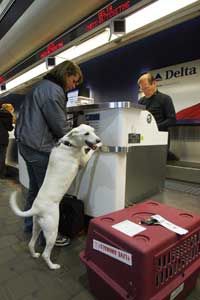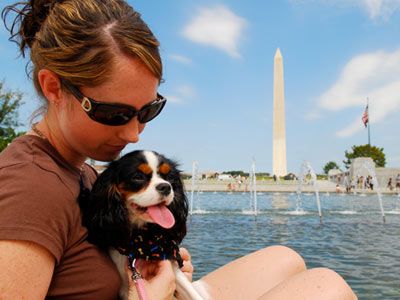If you've ever read Jim Davis' "Garfield" comic strip, you've probably observed one of the orange feline's frequent attempts to airmail Nermal the kitten to Abu Dhabi, capital of the United Arab Emirates. It's easy to laugh at such exploits, at least until you consider the possible consequences. Assuming Nermal's box made it through security, the airline might store the kitten in an unpressurized cargo hold without temperature regulation. Even if Nermal survived without food or water for the duration of the trip and didn't endure lethal temperature extremes, he might well have to be euthanized when the plane touched down in the Middle East.
Luckily, such tragedies are rare today, but flying can be a dangerous and stressful undertaking for a pet, even if feline-plotted foul play isn't a factor. Most airlines recommend that a pet be at least 8 weeks old and properly weaned before it flies. Even if your pet is a healthy adult, it might not be a good idea to take it on a plane. Some snub-nosed cats and dogs have trouble breathing, and some dog breeds, such as pugs, overheat easily, making them less-than-ideal checked baggage.
Still, most airlines allow you to ship pets, unaccompanied, as cargo. The exact rules regarding their transport vary depending on the airline, destination and animal breed, but this method of transportation tends to see a pet confined to an approved carrier in a cargo hold.
Airlines allow customers to ship pets as cargo year-round in climate-controlled sections of the cargo hold, but often place restrictions on transport during particularly hot or cold weather conditions. The reason for this is that while the cargo area is temperature-controlled, other parts of the terminal may not be.
Baggage handlers typically strap animal crates in place and may wrap them with perforated air cushion rolls. Cargo hold size and conditions depend greatly on the type of plane and the airline that operates it. In many models, the baggage area takes up the level directly beneath the passenger cabins.
In the United States, airlines typically won't accept pet baggage if the forecast calls for temperatures bellow 45 degrees F (7 degrees C) or above 85 degrees F (29 degrees C) in order to meet regulations governed by the Animal Welfare Act. With proper acclimation certification, however, some animals may be permitted to endure hotter conditions or temperatures as low as 20 degrees F (-7 degrees C).
If you choose to bring your pet along as checked baggage, it will travel under the same conditions as those shipped as cargo. However, if you bring it along as a carry-on, the lucky cat or dog will get to experience the same flying conditions as you do. The only difference is that while you get to recline back in your seat and snack on peanuts, your furry friend will have to remain inside its carrier for the duration of the flight. If your pet happens to bark or meow a lot in confined spaces, be prepared to endure some hateful looks from your fellow passengers.
Of course, for the truly pampered pet, chartered flights are always a pricier alternative. One company, Companion Air, even hopes to offer pet-friendly flights in which the animals ride in specially designed passenger cabins.
Explore the links on the next page to learn even more about traveling with pets.



